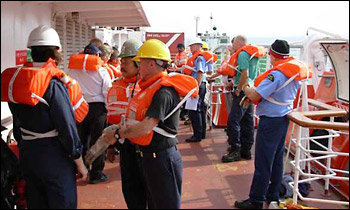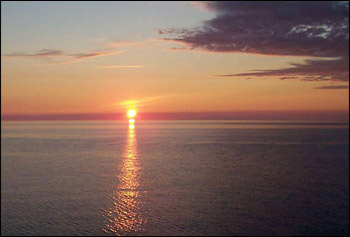Please note: You are viewing
the unstyled version of this website. Either your browser does not support CSS
(cascading style sheets) or it has been disabled. Skip
navigation.
Rick KrishfieldAugust 6, 2006
Safety is an important consideration on any vessel, but especially so on vessels traveling in frigid Arctic waters, and the Canadian Coast Guard takes their preparedness seriously. So after lunch (or, the dinner meal in Canada), the emergency alarm sounded (consisting of a continuous ringing) and all the ship's complement was required to grab the life preserver in their cabin and head to their specific muster point, which happened to be the helicopter hanger for most of the scientific supernumaries. Typically, everyone would also be bundled up with warm clothing, hats and gloves for Arctic temperatures, but on this hot day the Captain provided special dispensation so that we need not suffer in our heavy attire. The boat station signal is seven or more short blasts followed by one long blast of the ship's whistle and alarm bells. Lifeboats are located on both sides of the ship--everyone needs to know which boat to go to when the alarm sounds. The crew practiced lowering the lifeboat. The scientists' duties are to assist as directed. For the few scientists that have not been oriented on the ship, 2nd Officer Marie-Josee (MJ) Beaudoin provided a tour of the ship, pointed out the exits, emergency fire doors, and various safety equipment, and then had each individual try on an emergency exposure suit (which would only be donned during the extreme case of abandoning ship). Now we were prepared to depart. Around 4 PM local time, the ship's anchor was hoisted and the ship slowly, almost undetectably, began to move through the calm ocean. The ship is so large, and the sea so still, that the only way to be sure that we were moving was look over the side for a wake. Soon we were heading west toward Amundsen Gulf. Last updated: October 7, 2019 | |||||||||||||||||
Copyright ©2007 Woods Hole Oceanographic Institution, All Rights Reserved, Privacy Policy. | |||||||||||||||||




